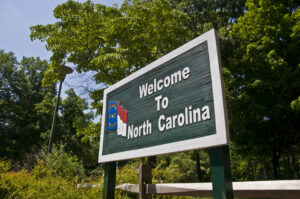
There are various explanations for the origination of the term “tar heel.” Perhaps the most convincing explanation is North Carolina’s early history of being a large exporter of tar. Regardless of the origin, the name has stuck and North Carolina is known as the Tar Heel State.
Business Climate:
North Carolina is the tenth most populated state in the country at an estimated 10 million in 2013. The city of Raleigh is considered one of the best places to work due to lower business costs than the national average and a highly educated workforce stemming from prominent universities such as UNC Chapel Hill, Duke University, North Carolina State University and many more. North Carolina is home to the Research Triangle Park, the largest research park in the country which has become a hot spot for technology and life science companies. In this area, there are over 190 companies with over 50,000 employees.
The state’s key industries include manufacturing, aerospace and aviation, defense, automotive, green energy, biotechnology, financial services, software and information technology. Charlotte, North Carolina is the second largest financial center, only behind New York City. According to the Charlotte Chamber, the total value of assets held by banks headquartered in the city is over $2.3 trillion in comparison to New York City’s $4.1 trillion and San Francisco’s $1.3 trillion. Its financial dominance is anchored by five of the top U.S. banks including Bank of America, the nation’s second largest bank.
Taxes:
Despite the state’s low cost of living and great weather climate, according to the 2014 State Business Tax Climate Index North Carolina ranks unfavorably at 44 out of 50. However, the Tax Simplification and Reduction Act enacted in July 2013 brought a brighter outlook for the state’s tax climate that should be beneficial in their rankings for years to come. Changes include a 5.8% flat rate on individual income tax, compared to a progressive tax rate as high as 7.75%. Other changes include a reduced corporate income tax rate (6.0% down from 6.9%) and a repeal of the estate tax. According to the Tax Foundation, in 2014 the combined state and local sales tax average was 6.9%, which ranks 25th nationally.
For the fiscal year ended in June 30, 2013, North Carolina’s tax revenue exceeded $20 billion. $11 billion, more than half of the revenue, came from individual income tax. Sales and use tax revenue accounted for $5.5 billion and corporate income tax collected was $1.2 billion.
A unique tax to the state is the Highway Use Tax. When title of an automobile is transferred, depending on the type of vehicle it is, a corresponding tax is assessed. For the everyday car purchase, it is 3% of the total purchase price in lieu of a sales tax. Taxes collected from the Highway Use Tax are used for the improvements of the roads of North Carolina.
Tax Credits & Incentives:
Below are various tax credits and incentives that are offered to qualified taxpayers and businesses who meet certain criteria.
Renewable Energy Tax Credit: This tax credit is offered to taxpayers and businesses for investing in machinery, equipment or real property classified as renewable energy property. A few examples of renewable energy property include biomass equipment, hydroelectric generators, and geothermal heat pumps. The credit amount is equal to 35% of the cost of property subject to certain limitations. If placed in residential property there are several ceilings for the type of renewable energy property placed in service, whereas in a nonresidential property there is a ceiling of $2.5 million per installation regardless of what type of energy source it is.
Tax Credits for Growing Businesses Act: Qualified businesses can receive credits equivalent to 50% of the state income tax, franchise tax, or gross premium tax liability. This program provides several ways to generate a credit such as creating new jobs, investing in business property, and investment into real property. North Carolina has a system that classifies each county into one of three tiers. Tier 1 counties are the most distressed counties in the state and Tier 3 is the least distressed. Thus, businesses in Tier 1 counties will receive a higher amount of credit. For example, companies that create jobs in a Tier 1 county can receive up to $12,500 credit per new job whereas those in a Tier 2 and Tier 3 county can earn $5,000 and $750, respectively. These credits are taken in four equal installments either over four years (for creating jobs and investing in business property) or seven equal installments over seven years (for investment into real property).
Research and Development Tax Credit: A qualified business is allowed a tax credit for research expenses as long as the taxpayer maintains specific wage standards, health insurance, environmental impact, and safety and health programs. The credit is equivalent to 3.25% of the research expenses for small and/or low-tier businesses. Businesses in other tiers are entitled to a credit of 1.25% for amounts under $50 million. The applicable percentage increases if the research expenses are higher. For example, if a company’s research expense is above $50 million, but below $200 million then the applicable percentage is 2.25%. If the company has over $200 million in research expenses then the applicable percentage is 3.25%.
Random North Carolina Facts:
- The Biltmore House located in Asheville is considered the largest privately owned home built in the United States with over 250 rooms and over 178,000 square feet of floor space. It was built between 1889 to 1895 by George Washington Vanderbilt II.
- The Wright Brothers’ first powered airplane flight occurred on a beach at Kitty Hawk on December 17, 1903.
- The first public university in the United States is the University of North Carolina Chapel Hill, which first opened its doors to students in 1795.
- Pepsi Cola was invented in New Bern, North Carolina in 1893. Its original business went bankrupt during the Great Depression and was bought by Loft Inc., which would eventually become PepsiCo and is now headquartered in New York.
- Charlotte has the largest population in the state at over 775,000 in 2012.
Photo Credit: T. Bain via Flickr












